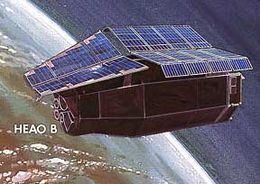Mission type Astronomy COSPAR ID 1978-103A Mission duration 4 years | SATCAT no. 11101 | |
 | ||
Website Einstein Observatory at NASA.gov | ||
Einstein Observatory (HEAO-2) was the first fully imaging X-ray telescope put into space and the second of NASA's three High Energy Astrophysical Observatories. Named HEAO B before launch, the observatory's name was changed to honor Albert Einstein upon its successfully attaining orbit.
Contents
Launch
The Einstein Observatory, HEAO-2, was launched on November 13, 1978, from Cape Canaveral, Florida, on an Atlas-Centaur SLV-3D booster rocket into a near-circular orbit with an initial altitude slightly above 500 km. Its orbital inclination orbit was 23.5 degrees. The Einstein Observatory satellite re-entered the Earth's atmosphere and burned up on March 25, 1982.
Instrumentation
The Einstein Observatory carried a single large grazing-incidence focusing X-ray telescope that provided unprecedented levels of sensitivity (hundreds of times better than previously achieved) and arc-second angular resolution of point sources and extended objects. It had instruments sensitive in the 0.2 to 3.5 keV energy range. A collection of four focal-plane instruments was installed in the satellite:
There was also a coaxial instrument 'MPC', the Monitor Proportional Counter, working in the 1-20 keV range, and two filters that could be used with the imaging detectors:
